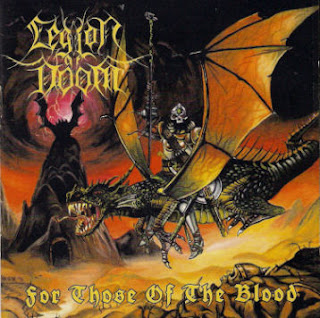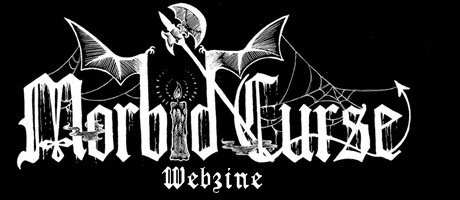
|

|

Like some of the other bands in the Hellenic scene, Legion of Doom
started out playing a rather boring form of death metal. However, by the time they released their debut album, 1995's Kingdom of Endless Darkness, Mortuary and Demogorgon had shifted the band's style more
in line with the second wave black metal sound that was spawned in the north. This record has little or nothing to do with
the typical style played by the likes of Rotting Christ or Varathron.
Musically, Kingdom
of Endless Darkness seems to owe a great deal to the Norwegian bands that preceded them. In particular, many of the
riffs are reminiscent of early Burzum and Darkthrone. Upon first listen, this comes off as being rather generic and one may
be quick to write the band off as merely another copycat outfit that listened to Hvis Lyset
Tar Oss or Transilvanian Hunger too many times. (This is especially obvious
during "The Desecration", which makes use of a familiar-sounding synth line and a guitar melody that seems lifted from "Det
Som En Gang Var".) While the overall approach is similar, being rather minimalist with the fast tremolo melodies, grim vocals
and high-speed drum programming, there is a level of quality to the songwriting that is absent in the case of many that hoped
to mimic the hordes of the north. The manner in which the riffs are constructed displays the skill of the musicians, as they
are able to create such a dark and menacing atmosphere with so little. Most of the songs are relatively brief, though the
title track is over fifteen minutes in length. This one offers subtle changes in the main theme that slowly unfold, as the
song progresses. Much like Burzum's older works, this allows the listener to be pulled in and put in an almost trance-like
state as the guitar melodies wash over them and the atmosphere starts to bleed forth. Also of interest is the track's placement
within the album, coming second rather than at the beginning or end of the record, which is more traditional for such epics.
The rest of the songs are below average in length, by any standard, yet they manage to accomplish nearly as much as the title
track. Each one maintains a similar style, being rather straightforward and rarely straying from the consistent pace that
is established early on. The one song that stands out the most is "The Black Queen", mainly due to the sheer bleakness and
overwhelmingly dismal atmosphere created by the main riff. It also has a little more room to develop, as it stretches a little
beyond five minutes.
The production is pretty grim for its time, moreso when considering how many bands were already
offering up more polished and fake-sounding albums by this point. There is a decent level of fuzz that remains throughout
the whole record. The drum machine is fairly easy to detect, but not because of its level in the mix. It may have been hidden
a slight bit more, but there was no real need for that. It was common enough, among some of the Hellenic black metal bands,
to utilize such things in the absence of actual drummers. The vocals are kind of in the middle and rather difficult to decipher,
though this is more a result of the style than the production. Again, this would seem run-of-the-mill and average to someone
that did not pay close attention. However, the mix favours the guitars enough to allow the riffs to accomplish their intended
goals.
For those that pick up a copy of Kingdom of Endless Darkness in order
to hear more typical Hellenic black metal, you will be sorely disappointed. It is simple to tell that Legion of Doom were
far more influenced by Burzum than Rotting Christ. That said, there is still enough going on with this record to make it of
interest to fans of either scene. Of all the bands to spring up around this time period, Legion of Doom were certainly among
the more skilled. By 1995, many of the northern hordes were losing their way and churning out uninspired filth that only served
to tarnish their legacies. However, the evil that once possessed them was still wreaking havoc from the dark corners of Europe.
Toss the experimental / symphonic garbage aside and seek this out.
(3 Jan. 2012)

For Those of the Blood is
the second full-length album from Legion of Doom. Released in 1997, this album may be responsible for the fact that the band
never rose to the same level of notoriety as fellow Greek bands such as Rotting Christ or Necromantia. Rather than develop
more of their own style, or even to adopt the type of approach that was being utilized by many in the Hellenic black metal
scene, Legion of Doom continued to take their cues from the northern lands and made some of the same mistakes.
One
cannot find many flaws in the songwriting department. As it compares to Kingdom of Endless
Darkness, the basic material is in the same vein. However, there is much less of a Burzum influence on this record.
Instead, most of the tremolo riffs and rapid drumming seem inspired by early Darkthrone, primarily, as well as Emperor and
a few others from Norway. While it is not, necessarily, a bad thing that they still followed the lead of their Scandinavian
heroes. This album introduces a very strong symphonic element that waters down the atmosphere and gives it a rather cheesy
feeling. The synth is overused and done in an improper manner to begin with, taking away any possibility that the song had
to maintain a dark feeling. Furthermore, the actual riffs are much more generic and less memorable. "Messenger..." manages
to stand out among the rest of the average and mediocre tracks, mostly due to being more straightforward and placing the emphasis
back on the guitars, where it belongs. "Κυρες" would be included in that, as well, but the percussion
overpowers the riffs, at times. Legion of Doom still employed a drum machine, at this point, and they did not seem concerned
with making sure it was buried in the mix.
As for the rest of the production, the overall sound is a little cleaner
than on the previous album. The guitar tone, especially, lacks the raw edge that it possessed on Kingdom of Endless Darkness and loses a bit of character as a result. It comes off as a bit more smooth and
polished, though it is still far from drowning in the typical modern, plastic sound. It actually sounds rather necro, if one
compares it to an album like Triarchy of the Lost Lovers, for example. The drum machine
is too high, taking a bit of the attention away from the guitar riffs. The grim vocals are still right where they should be,
in relation to the guitars.
Skipping the instrumentals, there is less than half an hour of music on this album. Of
that material, a good deal of it is tainted by symphonic nonsense that does nothing to add to the dark feeling that should
have been the main goal of For Those of the Blood. In the end, this record represents
a drop in quality from its predecessor. Less selective listeners may be able to look past its flaws, but I would say that
this L.P. is somewhat disappointing and less worth the time to track down.
(6 Jan. 2012)
|

|

|


